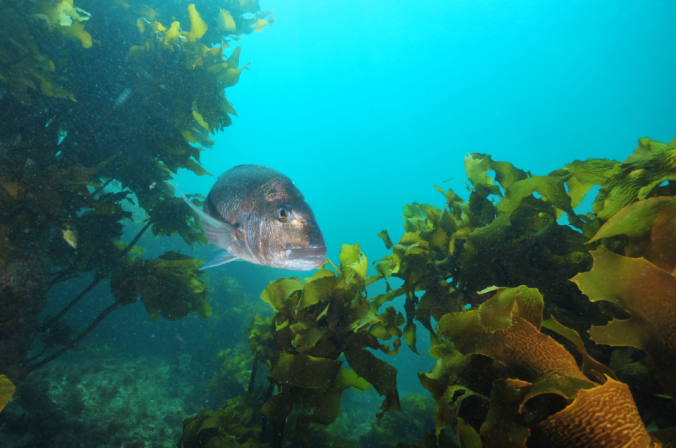
Daniel Poloha/shutterstock.com
Thanks to the Conversation for highlighting the potential of this inspiring technology.
How farming giant seaweed can feed fish and fix the climateBren Smith, an ex-industrial trawler man, operates a farm in Long Island Sound, near New Haven, Connecticut. Fish are not the focus of his new enterprise, but rather kelp and high-value shellfish. The seaweed and mussels grow on floating ropes, from which hang baskets filled with scallops and oysters. The technology allows for the production of about 40 tonnes of kelp and a million bivalves per hectare per year.
The kelp draw in so much carbon dioxide that they help de-acidify the water, providing an ideal environment for shell growth. The CO₂ is taken out of the water in much the same way that a land plant takes CO₂ out of the air. But because CO₂ has an acidifying effect on seawater, as the kelp absorb the CO₂ the water becomes less acid. And the kelp itself has some value as a feedstock in agriculture and various industrial purposes.
After starting his farm in 2011, Smith lost 90% of his crop twice – when the region was hit by hurricanes Irene and Sandy – but he persisted, and now runs a profitable business.His team at 3D Ocean Farming believe so strongly in the environmental and economic benefits of their model that, in order to help others establish similar operations, they have established a not-for-profit called Green Wave. Green Wave’s vision is to create clusters of kelp-and-shellfish farms utilising the entire water column, which are strategically located near seafood transporting or consumption hubs.
The general concepts embodied by 3D Ocean Farming have long been practised in China, where over 500 square kilometres of seaweed farms exist in the Yellow Sea. The seaweed farms buffer the ocean’s growing acidity and provide ideal conditions for the cultivation of a variety of shellfish. Despite the huge expansion in aquaculture, and the experiences gained in the United States and China of integrating kelp into sustainable marine farms, this farming methodology is still at an early stage of development.
Yet it seems inevitable that a new generation of ocean farming will build on the experiences gained in these enterprises to develop a method of aquaculture with the potential not only to feed humanity, but to play a large role in solving one of our most dire issues – climate change.
Globally, around 12 million tonnes of seaweed is grown and harvested annually, about three-quarters of which comes from China. The current market value of the global crop is between US$5 billion and US$5.6 billion, of which US$5 billion comes from sale for human consumption. Production, however, is expanding very rapidly.
Seaweeds can grow very fast – at rates more than 30 times those of land-based plants. Because they de-acidify seawater, making it easier for anything with a shell to grow, they are also the key to shellfish production. And by drawing CO₂ out of the ocean waters (thereby allowing the oceans to absorb more CO₂ from the atmosphere) they help fight climate change…
…What might a kelp farming facility of the future look like? Dr Brian von Hertzen of the Climate Foundation has outlined one vision: a frame structure, most likely composed of a carbon polymer, up to a square kilometre in extent and sunk far enough below the surface (about 25 metres) to avoid being a shipping hazard. Planted with kelp, the frame would be interspersed with containers for shellfish and other kinds of fish as well. There would be no netting, but a kind of free-range aquaculture based on providing habitat to keep fish on location. Robotic removal of encrusting organisms would probably also be part of the facility. The marine permaculture would be designed to clip the bottom of the waves during heavy seas. Below it, a pipe reaching down to 200–500 metres would bring cool, nutrient-rich water to the frame, where it would be reticulated over the growing kelp.
Von Herzen’s objective is to create what he calls “permaculture arrays” – marine permaculture at a scale that will have an impact on the climate by growing kelp and bringing cooler ocean water to the surface. His vision also entails providing habitat for fish, generating food, feedstocks for animals, fertiliser and biofuels. He also hopes to help exploited fish populations rebound and to create jobs. “Given the transformative effect that marine permaculture can have on the ocean, there is much reason for hope that permaculture arrays can play a major part in globally balancing carbon,” he says.
This is an edited extract from Sunlight and Seaweed: An Argument for How to Feed, Power and Clean Up the World by Tim Flannery, published by Text Publishing.
Read the entire article here.
Share this:




